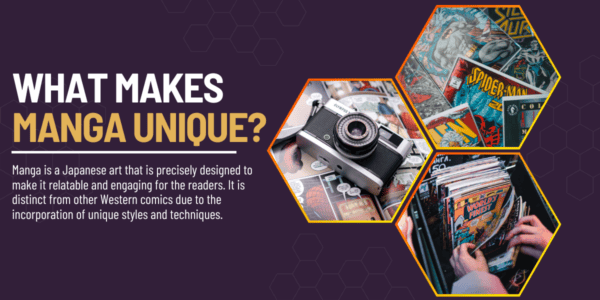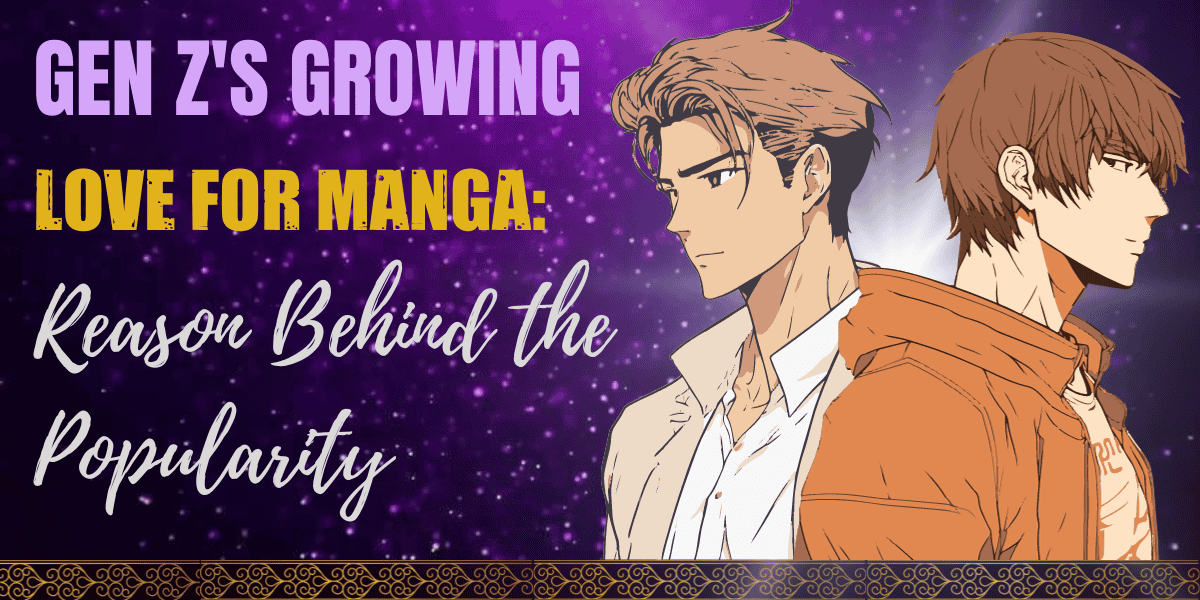In the Gen Z world, apart from the growing popularity of K-Pop, J-Pop, K-Drama, J-Drama, and Anime, there is one more addition to the list, i.e., Manga.
For people who aren’t familiar with the word Manga, let me briefly describe it for you. Manga is a term used for a wide range of comic books and graphic novels produced and published originally in Japan.
Nowadays, you will see the young generation’s bookshelves filled with mangas. In their free time, rather than sitting idly, they prefer cozying up on their bed with a bowl of ramen and manga comics to read.
But what exactly is manga? And why is it becoming so famous? Mangas history dates back to the 12th century, and today, I will break down the basics of this art form and also explain why it is one of the first choices of youngsters.
So, without further ado, let’s start with this very interesting topic of MANGAS!
What is Manga?
Originally originated in Japan, Manga is a name given to the large variety of comic books and graphic novels. The word Manga is formed by uniting two Japanese words, “man,” which means “whimsical,” and “ga,” which means “pictures.”
Mangas are always published in black and white, and colorful comics are reserved for special releases. One interesting fact about Japanese Manga is that it is read from right to left, which means anyone who wants to read it in its original language should follow this reading technique.
Mangas are released on a weekly or monthly basis and can be found in Manga magazines. Tankōbon is a Japanese book that publishes the stories of popular mangas.
Brief History of Manga

Manga dates back to the 12th and 13th centuries, with the very first manga appearing in a series of drawings. However, the actual concept of manga started in the Edo period, and in the 18th-19th century, it finally got recognition and popularity.
Manga got global recognition when it was adapted into anime series such as Dragon Ball Z, Sailor Moon, and My Neighbor Totoro. Due to this, people from different countries started reading mangas and loved the stories, becoming enthusiastic fans.
With the technology upgrade, print and digital mangas are available in various languages and genres. Mangas’s popularity is also increasing because of the anime adaptions of these comics, which are reaching vast audiences worldwide.
What is the Difference Between Manga and Anime?
There is a common misconception that manga and anime are similar and can be used interchangeably. But this is not true!
Manga is a printed form, and anime is a visual representation through screens. Manga is released in the form of comic books and novels, which must be read, whereas anime is an animated film created with sound, motion, and more to enhance the overall experience of viewers.
Manga is created by an individual artist known as a mangaka, whereas for the creation of animes, a big team is needed, including animators, voice actors, etc. Many anime are adapted from mangas, but not all animation stories are based on these comics.
So, people must understand that mangas are a part of print media, and anime comes under visual media.
What Makes Manga Unique?

Manga is a Japanese art that is precisely designed to make it relatable and engaging for the readers. It is distinct from other Western comics due to the incorporation of unique styles and techniques. I will list a few points to explain how manga is unique and interesting. Have a look!
Art Style
While reading a manga, you will notice that the sketches have a distinctive style. The drawings are varied and highly detailed. The characters have oversized eyes and white skin, wear school uniforms, and many other characteristics are incorporated to illustrate their expressions and emotions, alongside giving them a realistic setting.
The artist draws each element with precise details so the readers can comprehend the story easily with the images and dialogues. Japanese mangas are printed in black and white format and must be read from right to left.
Storytelling

The storytelling techniques of Mangas are very slow-paced and clear. The focus is to create the overall mood, setting, and emotions and exaggerate the plot to build up the suspense and maintain the interest of the readers.
Artists need to focus on the panel layout, character design, background settings, and more to give it a perfect structure.
Characters
The development of characters is also an important aspect. Mangaka must show the character build-up through visuals and dialogues to keep the readers interested throughout. In the manga, you can feel the characters’ conflicts, empathy, emotions, etc., that are beautifully incorporated and demonstrated.
Plot

Plot is the main part that creates the foundation for any manga story. Mangakas focuses on making the plot as engaging as possible to entertain the readers. Various techniques are used for plot build-up, along with working on the plot environment to create the setup and overall mood of the story.
Dialogue
Mangas differ from novels because they have both texts and drawings to demonstrate the story. Dialogues are essential because the communication between the characters depicts the thoughts, opinions, and tension that helps the story to move forward. The communication in the mangas is very comprehensive to make it understandable for the readers.
Types of Manga

Mangas can also be categorized into different types according to the genres and demographics. However, the audience of a specific manga story depends on the preference of an individual. Let’s know about a few types of manga.
Shojo
A shojo manga basically targets teenage girls. This does not mean shojo cannot be read by teenage boys or adults. But the manga is designed for young girls, and the genre varies, such as romance, suspense, etc.
Seinen
Seinen manga is for adult men and contains action, horror, and more adult content. This manga is more mature and demonstrates real-life hardships without sugar-coating it.
Shonen
Similar to shojo, the shonen manga is targeted towards teenage boys. This type of manga includes action, comedy, friendship, adventure, etc. Shonen manga can be read by anyone without any age restrictions.
Josei
Josei manga is for adult women who are more than 18 years of age. It has more mature content regarding relationships, life, obstacles, etc. Josei has a profound storyline with various themes incorporated.
Yaoi
This manga is also called BL or Boys Love and is trending nowadays. Yaoi is mainly for women as it includes love/romance relationships between men.
Yuri
Yuri is for both men and women, and it contains stories about love/romance relationships between women.
Reasons Behind Gen Z’s Love for Manga
If we talk about recent trends in the media industry, anime and manga are breaking the markets. But it can be said that Japanese graphic novels, i.e., mangas, are at the top due to the rapid increase in their adaption by other industries.
Manga is really flourishing in the foreign markets, including the US market. Manga was already popular in Asian culture, but over the course of time, it reached the global market effortlessly. The pandemic was also a reason for the manga reaching the masses, mainly Gen Z.
Initially, manga and anime were called nerdy things, but now, with increasing fandom, it has become cool and trendy. Majority of the audience prefers reading these graphic novels nowadays because of their engaging plot and unique styles.
The curiosity to understand Japanese culture in depth is one of the reasons for the fame. The adaptation of mangas into anime, Kdrama, and J-drama also plays an important role in the increase in sales. Gen Z now prefers more action and realistic stories with an essence of personalization over cliche plotlines.
Manga also has pop culture relevance, violence, youth aspirations, intimacy, and amazing graphic illustrations that add to the list of reasons why they are so famous among youngsters and many adults as well.
So, we can say that Gen Z has somewhat different tastes when it comes to visual and print media, and the love for manga is breaking all the cultural differences between continents.
Wrap-Up
The upcoming generations are more inclined towards realistic views, whether it be the fictional world or real life. The preference of Gen Z for various things can be taken as examples to understand the variation in trends over time.
The motive behind this article was to highlight how the youth world is changing and also to provide a brief idea behind the concept of Manga. I believe mangas are really good and people of every age should try them once.
It’s never too late to keep up with the trends!
Are you a manga lover? Which is your favorite manga? Kindly share a few good manga recommendations in the comments.



